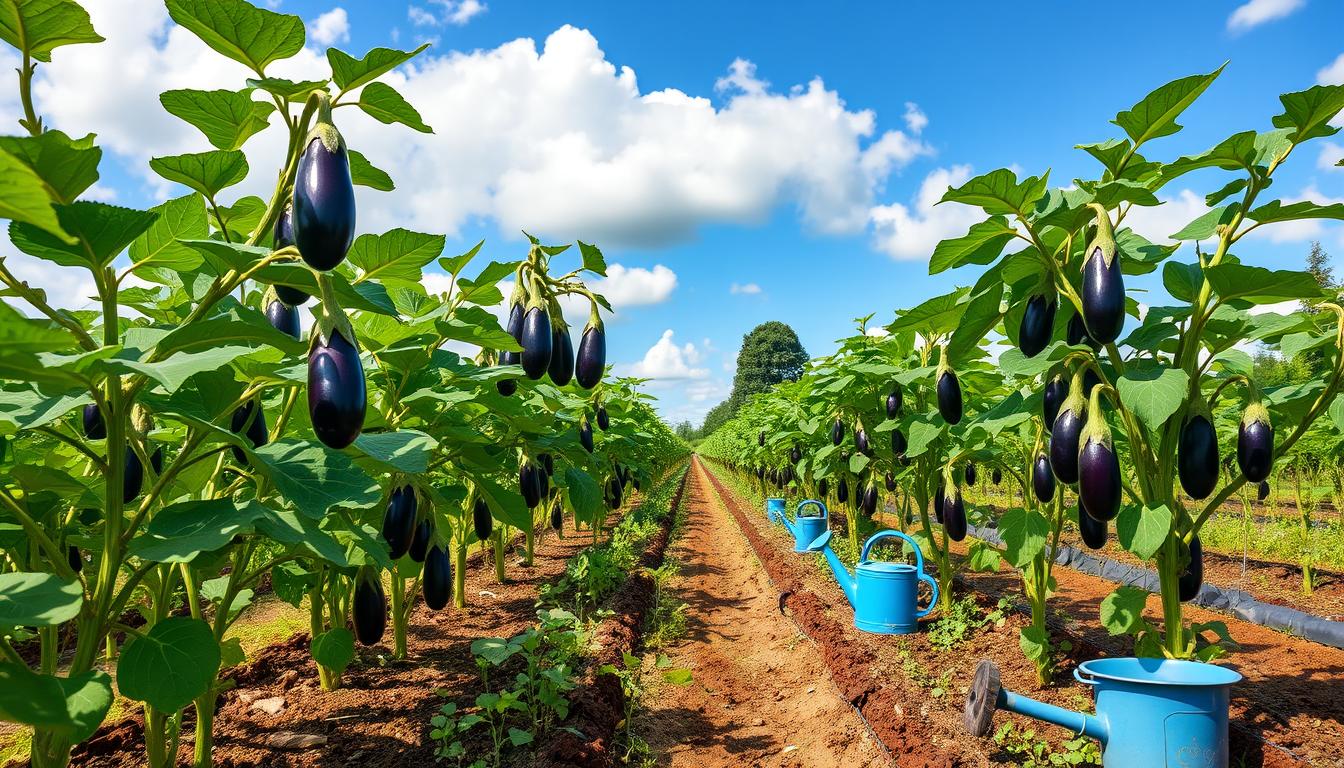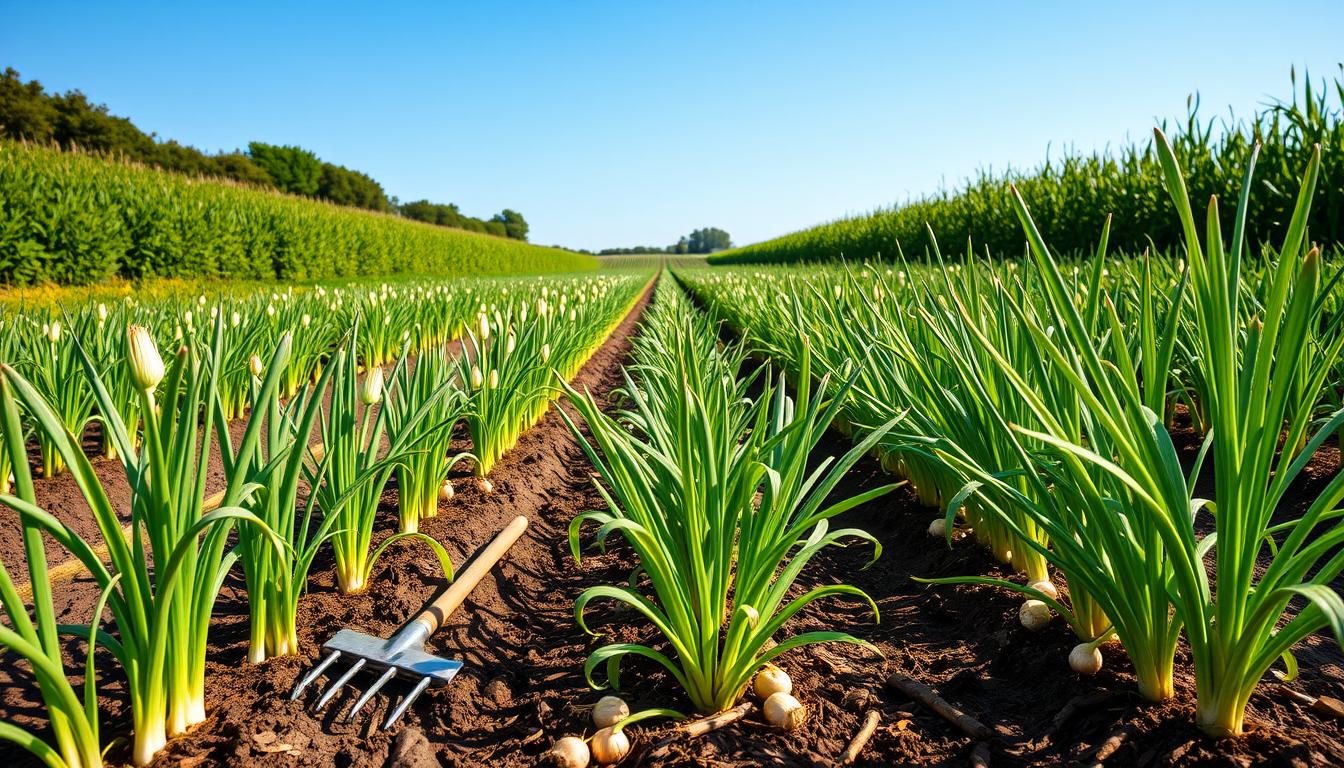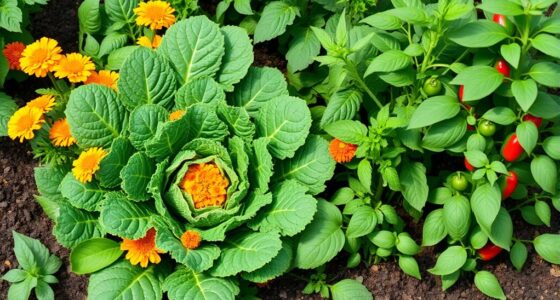Have you ever savored the rich, creamy texture of a perfectly cooked eggplant dish? Maybe a fragrant baba ganoush or a vibrant ratatouille? Growing your own eggplant gives a sense of connection to the soil and the satisfaction of nurturing something from a tiny seed into a fruitful harvest. Growing eggplant is not just about food. It’s about the joy and pride of gardening in your backyard. This guide will give you essential farming tips to embark on your eggplant growing journey. It ensures you enjoy the many benefits of this nutrient-rich vegetable found in dishes worldwide.
From choosing the best varieties to understanding soil and sunlight needs, this guide is your ally. It aims to help you confidently cultivate this versatile vegetable. Whether you love gardening or cooking, this eggplant cultivation guide is here for every step of the way. Let’s dive in and discover the secrets to becoming a successful eggplant farmer!
Key Takeaways
- Eggplants thrive in warm seasons, requiring temperatures between 70° and 85°F.
- They prefer well-drained, nutrient-rich soil with a pH level between 5.8 and 6.5.
- A minimum of 6 to 8 hours of direct sunlight daily is essential for healthy growth.
- Regular watering and appropriate fertilization can enhance your eggplant yield.
- Understanding different eggplant varieties will help you choose the best fit for your garden.
Introduction to Eggplant Cultivation
Eggplants, also known as brinjal or aubergine, make your garden and kitchen more interesting. This guide shows the importance of the right conditions for growing. They need warm places, with temperatures of 26–32°C (80–90°F) during the day. At night, they prefer it around 21°C (70°F). It’s important to know that cold weather, below 16°C (60°F), can slow their growth.
To start growing eggplants, you need well-drained, fertile soil. The pH should be between 5.5 and 7.5. Good soil lets roots grow strong. It should be rich and keep enough water without being too wet.
Eggplants can get pretty tall, around 60–120 cm (24–48 inches), and sometimes even 1.5 m (5 feet) in tropical places. When planting, leave about 45-60 cm (18-24 inches) between them. This space is good for their growth and helps keep the plants healthy. It makes your garden look good and helps prevent diseases.
If you want to grow eggplants in cooler areas, start seeds indoors 8-10 weeks before the last frost. This helps them grow in warm soil later. They need lots of sunlight, eight to ten hours daily. Follow these tips, and you’ll enjoy a great eggplant harvest in about 12-15 weeks.
Understanding Eggplant Varieties
Eggplants have many shapes, sizes, and colors. They offer a wide variety for gardeners and cooks. Learning about these varieties lets you enjoy each one’s unique features. You can create amazing meals. This part will tell you about the best types of eggplants. You’ll also get advice on picking the right one for your garden and kitchen.
Popular Types of Eggplants
Some eggplant types are really special because of how they look and taste:
- Black Beauty: This variety has deep purple skin and is very meaty. It’s great for many recipes.
- Ichiban: A long, Asian eggplant, Ichiban has soft skin and a sweet taste. It’s perfect for stir-fries.
- Casper and White Beauty: These white eggplants are good for caponata and baba ghanoush. They have a gentle taste.
- Taiwan Pingtung Long: This eggplant is long and thin. It’s good for grilling or drying, making it versatile.
- Thai Green: An Asian type good for stir-fries. It brings a special flavor to your meals.
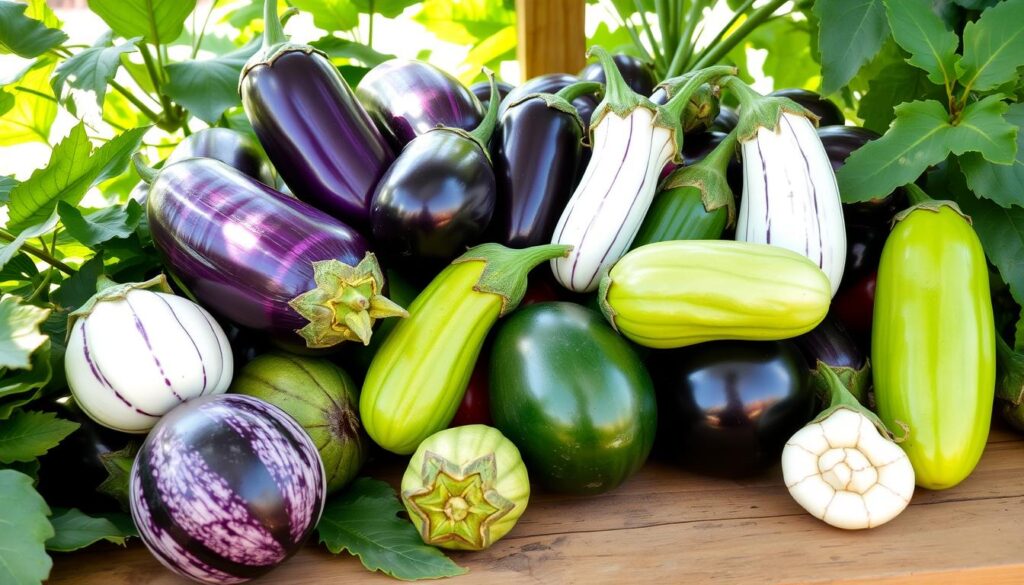
Choosing the Right Variety for Your Garden
To pick the best eggplant, think about a few important things:
- Climate: Eggplants do best in warm places, around 80 to 90 degrees Fahrenheit.
- Space: Some eggplants get tall, up to 36 inches. But, Asian types are shorter, around 18 inches.
- Usage: How you want to cook them matters. Bigger ones are great for certain dishes, like papoutsakia. Smaller types are good for grilling.
Choosing well means knowing how they grow and what you like. You can enjoy many eggplants that make your food better.
Basic Requirements for Growing Eggplants
To grow healthy eggplants, focus on location, sunlight, and soil quality. These key factors greatly affect yield and plant health. It’s crucial to create the best environment for them.
Location and Sunlight Needs
Eggplants need full sun, meaning at least six hours of direct sunlight daily. Sunlight is vital for photosynthesis, which promotes strong growth and fruiting. Insufficient sunlight leads to weak plants and fewer fruits. Make sure they’re placed in the sunniest spots.
Soil Quality and Amendments
The right soil is essential for growing eggplants. Aim for well-drained, nutrient-rich soil. Adding compost or aged manure will boost fertility and root health. It’s wise to check the soil’s pH too. Eggplants do best in a slightly acidic to neutral range.
Climate and Temperature Factors
Eggplants love warmth. They grow best in temperatures from 70 to 85 degrees Fahrenheit. Since they’re cold-sensitive, plant them after frost threats pass and the soil warms up. Remembering these tips on climate and temperature will help you succeed.
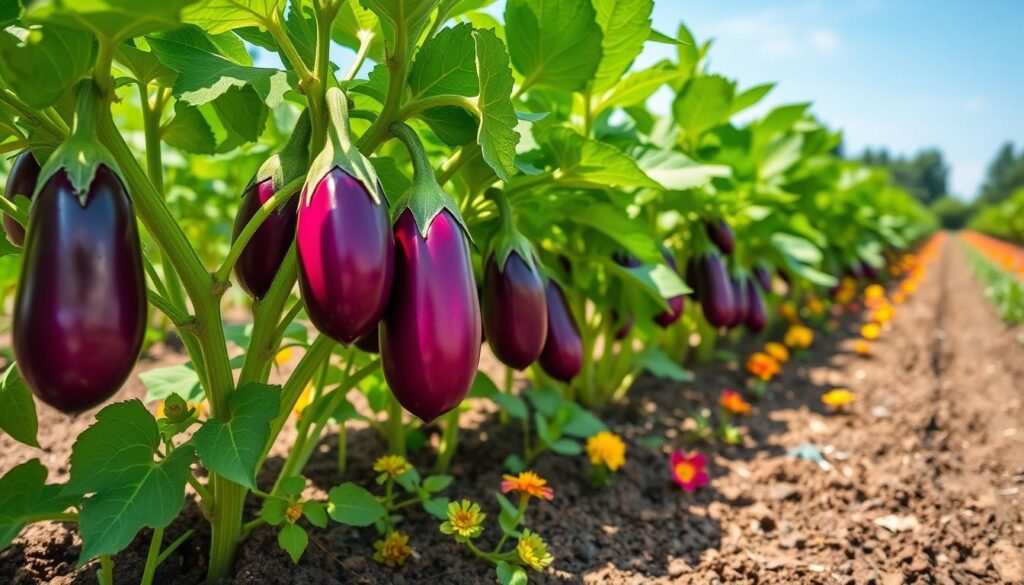
| Factor | Requirement |
|---|---|
| Sunlight | Minimum of 6 hours daily |
| Soil Type | Well-drained, rich in organic matter |
| Soil pH | 5.5 – 6.8 (slightly acidic preferred) |
| Ideal Temperature | 70°F – 85°F |
When to Plant Eggplants
For successful eggplant growth, timing is everything. They need warm weather, with temperatures over 50°F. Knowing when to start seeds and transplant them is key to a good harvest.
Starting Seeds Indoors
Start your eggplant seeds indoors 6-8 weeks before the last frost. This gives them a strong start. Seed starting tips include keeping soil at 70°F and moist. This makes your seedlings strong for later transplanting.
Timing for Transplanting Outdoors
Don’t transplant until nighttime temperatures stay above 50°F. Space your eggplants 18 inches apart, in rows 30-36 inches apart. Make sure your soil pH is 5.5 to 7.5 for best growth. This attention to detail ensures a bountiful harvest.

| Timing Activity | Details |
|---|---|
| Start Seeds Indoors | 6-8 weeks before last frost |
| Transplant Outdoors | After nighttime lows are above 50°F |
| Optimal Soil Temperature | 70°F for seedlings to thrive |
| Spacing | 18 inches apart in rows 30-36 inches apart |
| Soil pH | Between 5.5 and 7.5 |
Best Practices for Planting Eggplants
Starting with the right soil prep and planting methods is key. Doing things well at this stage really helps your eggplants grow. Here are the best steps for planting eggplants in your garden.
Preparing the Soil
First, get the soil ready for your eggplants. They love fertile soil that’s full of organic stuff. Add compost or old manure to the soil a bit before you plant. This makes the soil better and gives your plants more food.
The soil should have a pH between 6.0 and 6.8. Make sure it’s moist, but not too wet.
Planting Techniques and Spacing
Space your eggplants 24 to 36 inches apart. This helps air move around and keeps disease down. Make sure the ground is warm, at least 70°F, before you plant.
Carefully put seedlings in holes so the root ball’s top is even with the soil. Fill the hole back gently and water it well to settle the soil around the roots.
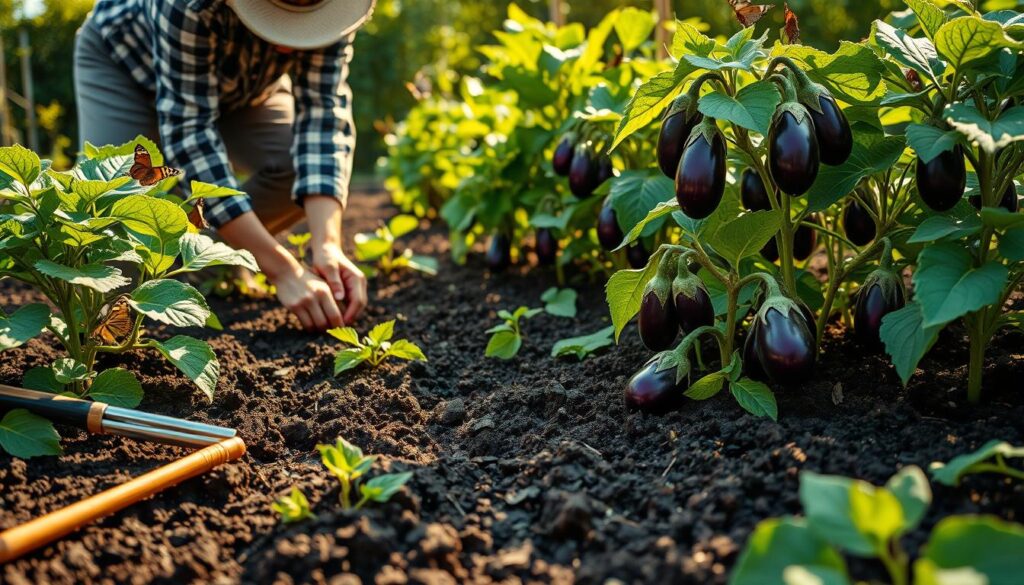
With good soil prep and careful planting, you’re on your way to a great eggplant garden. Keep an eye on your plants and feed them what they need to grow strong and productive.
Growing Eggplant | Farming Tips
Keeping your eggplants healthy during the growing season is crucial for a good harvest. We will cover important steps to boost your eggplant growth. These include proper watering, regular fertilization, and mulching.
Watering Guidelines
Watering your eggplant the right way is key. You should water deeply but not too often. Let the soil dry a little before watering again. This approach helps roots grow strong and prevents root rot. Keeping the soil moist, but not wet, is important for your plants’ health.
Fertilization Schedule
Having a fertilization plan is vital for a great yield. Start with a balanced fertilizer six weeks after the plants are in. Then, feed them every two weeks when they’re growing. Using fertilizers like 5-10-10 or 12-12-12 helps plants grow strong, especially in poor soils.
Mulching for Heat Retention
Mulching is great for your eggplant garden. It helps keep moisture in the soil and stops weeds. It also keeps the soil temperature steady. Using organic mulches like straw or leaves keeps roots warm. This is very helpful when it gets hot in the summer.

Pest Management and Troubleshooting
Keeping your eggplant garden healthy means constantly watching for pests and diseases. Eggplant pests can ruin your crop if you don’t handle them right. Knowing what to look for and how to deal with these problems can greatly improve your harvest.
Common Pests Affecting Eggplants
Several pests are known for damaging eggplants:
- Aphids: These small bugs can create dead spots on leaves and stop plants from growing if there are too many.
- Colorado Potato Beetles: Female beetles can lay more than 500 eggs in a few weeks, harming your plants.
- Flea Beetles: These tiny beetles, about 1.5 to 3 mm big, can have many generations in one year, making them a constant issue.
- Hornworms: They can get over 7.5 cm long. With two generations a year, they can repeatedly harm your crops.
- Cutworms: These larvae, usually 2.5 to 5.0 cm long, can cut down seedlings at ground level.
Dealing with Diseases
Garden diseases can also hurt your plants, aside from pests. Using smart pest management and disease control can save your eggplants:
- Use crop rotation to keep soil diseases away.
- Water properly to prevent too much moisture, which can cause fungal diseases.
- Keep plants healthy with soil nutrients and amendments, making them stronger against pests and diseases.
By following these steps, you will make your garden more resistant. This minimizes the damage pests and diseases can do to your eggplants.
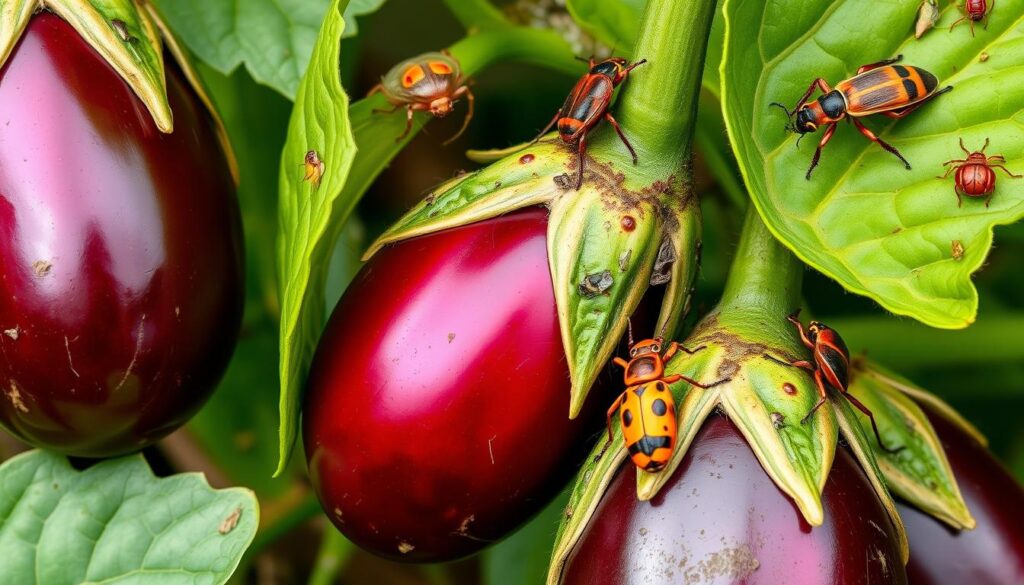
Harvesting Techniques for Optimal Eggplant Flavor
Picking eggplants at the right time is crucial for the best flavor. This makes sure they stay tender and not bitter. We’ll guide you on when to pick and the right way to do it.
When to Harvest
To pick eggplants at the best time, watch for these signs:
- Glossy Skin: A shiny, glossy skin means it’s ripe.
- Firmness: It should feel firm when you gently squeeze it.
- Color: Dark colors for some types, bright white for others show they’re ready.
- Seed Visibility: Ripe ones have seeds that you can’t see yet.
- Flesh Color: Inside should be cream-colored, not brown.
How to Properly Harvest Eggplants
Using the correct method to pick eggplants matters a lot. Here’s how to do it for the best quality:
- Cut the stem about an inch above the fruit with clean pruning shears or a sharp knife.
- Be gentle to avoid damage, as they’re quite fragile.
- Keep picking since they ripen at different times, over days or weeks.
- After picking, store them at room temperature, away from the sun for freshness.

With these harvesting tips, your eggplants will look and taste amazing. The right time and way to harvest lets you enjoy their flavor all season.
Storing and Using Harvested Eggplants
Keeping eggplants fresh after you pick them is key. You can enjoy their best taste and keep them longer by following some storage tips. Eggplants have a smooth texture and a taste all their own. That’s why so many people love to use them in different dishes.
Storage Solutions for Freshness
To keep eggplants fresh, put them in a paper bag in a cool place. This method works for up to two days. For a longer shelf life, store them in your fridge’s warmest spot. Keep it around 45°F to 50°F with 80-90% humidity. This way, they can last four to five days.
Don’t put cut eggplants right in the fridge because they might change color. Use an airtight container instead to keep the pieces fresh after cutting.
Delicious Cooking Ideas
Eggplant is great for cooking because it’s so adaptable. Here are some fun ideas to try with this unique veggie:
- Grill slices of eggplant for a smoky flavor.
- Incorporate eggplants into pasta dishes for a hearty and filling meal.
- Make a classic caponata by sautéing eggplant with tomatoes, olives, and capers.
- Prepare baba ghanoush by roasting eggplants and blending them with tahini and garlic.
- Stuff eggplants with your favorite mixture for a flavorful main course.
Using your imagination, you can discover new ways to cook with eggplant. It’s sure to be a tasty part of your meals.
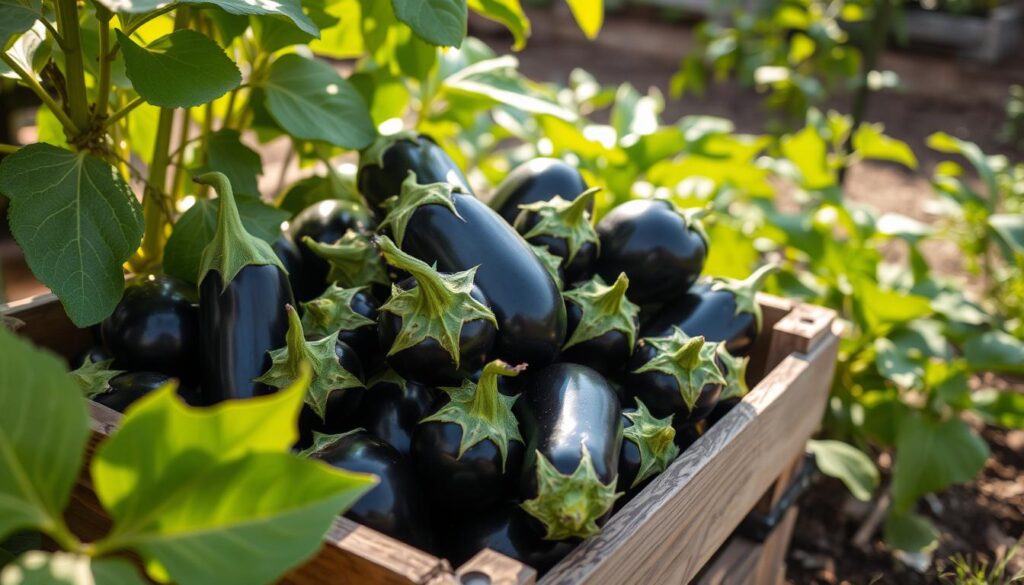
Eggplant Companion Planting Benefits
Companion planting offers many rewards for growing eggplants. It helps them grow better and stay healthy. Adding the right companion plants makes your garden more productive and eco-friendly.
Best Companion Plants
Several plants make great neighbors for eggplants. They help increase your garden’s yield and health:
- Marigolds: These colorful flowers keep away pests like nematodes and rodents. They also improve soil health.
- Onions: Onions are great for fighting off pests. They protect against aphids and spider mites.
- Beans: Beans are good for the soil. They add important nutrients back into the ground.
- Chives: Chives attract helpful insects and fight pests. They also make eggplants taste better.
- Mint: Mint’s strong scent wards off many pests. This includes aphids and cabbage moths.
How Companion Plants Improve Growth
Adding companion plants has many benefits for eggplant growth. They help create a balanced garden. They also make plants stronger against pests and diseases. Here are some ways they help:
- Tall plants provide shade. This keeps the soil moist for eggplants.
- Short plants keep weeds down. This lets eggplants get more nutrients.
- Nitrogen-fixing plants make the soil healthier. This leads to better eggplant growth.
- Diverse plants stop pests from spreading. This means fewer pests.
- More pollinators increase eggplant yields. This happens around companion plants.
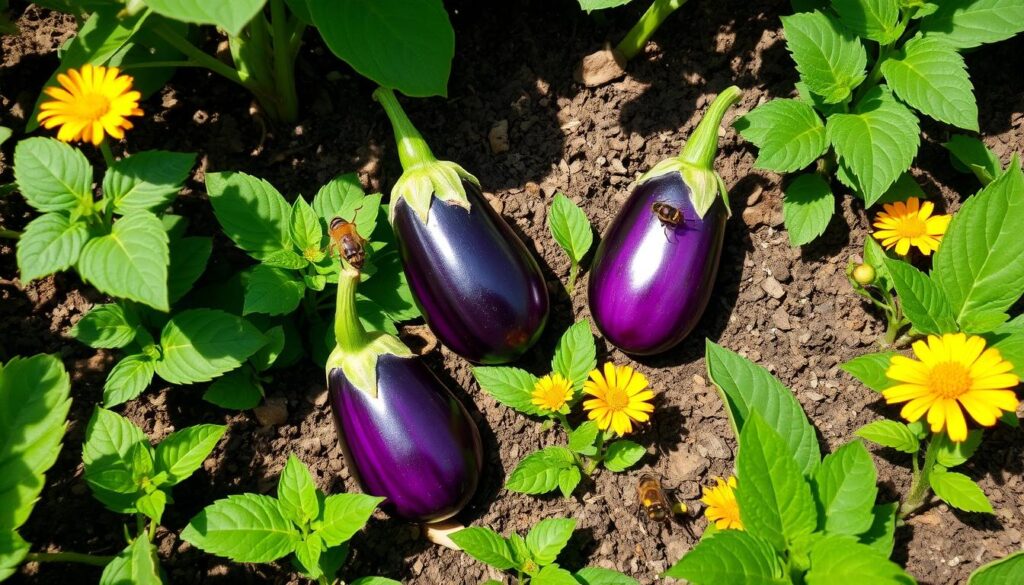
Smart companion planting leads to a healthier garden. It boosts the growth and productivity of your eggplants. By choosing the right plants to grow together, you help your crops and the environment.
Conclusion
Growing eggplants can be very rewarding. You can choose from varieties like Pandora Striped, Turkish Orange, or Long Purple Italian. The right soil pH of 7.0 is key to their health and taste. Make sure to plant them after the last frost and give them enough space.
Water your plants deeply but not too often to prevent root rot. Keep an eye out for pests like aphids and flea beetles. Use natural methods, like castile soap, to deal with them. These steps help fend off diseases and boost your gardening success.
Patience and learning from experience are crucial in eggplant cultivation. There’s a real joy in picking bright, firm eggplants. Dive into the journey of growing them. Enjoy the tasty meals and snacks they bring to your table. Happy gardening!

